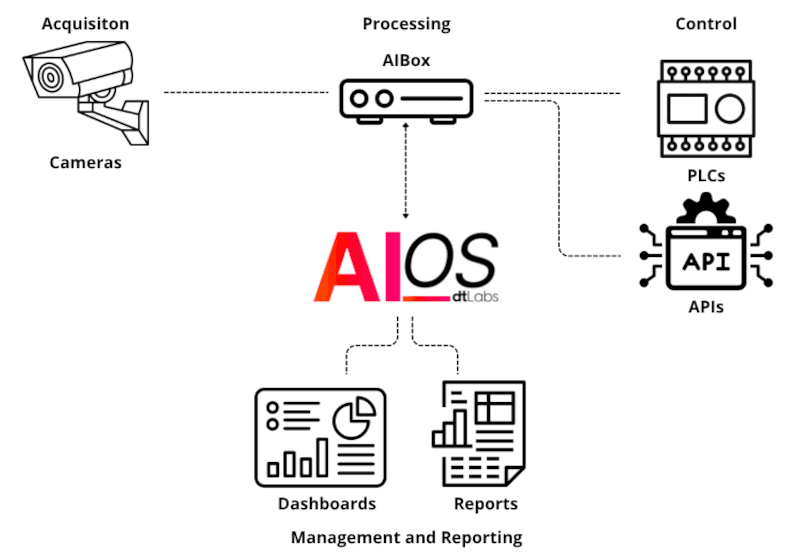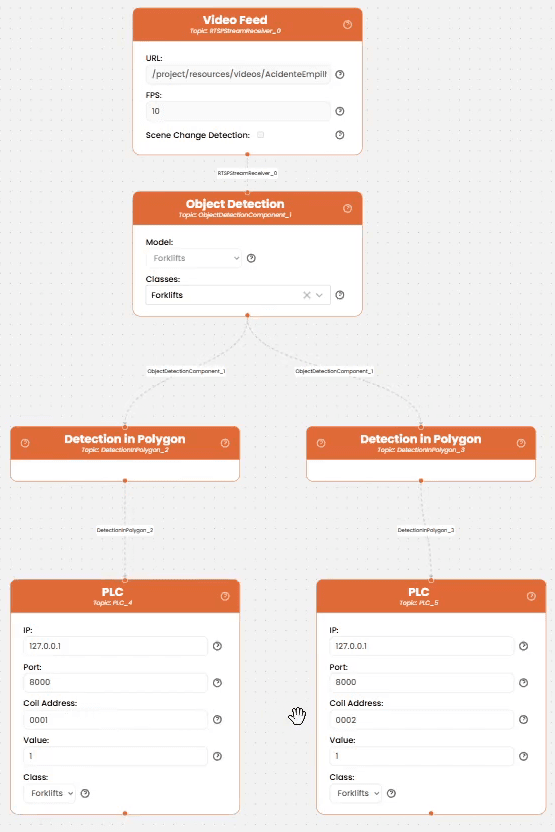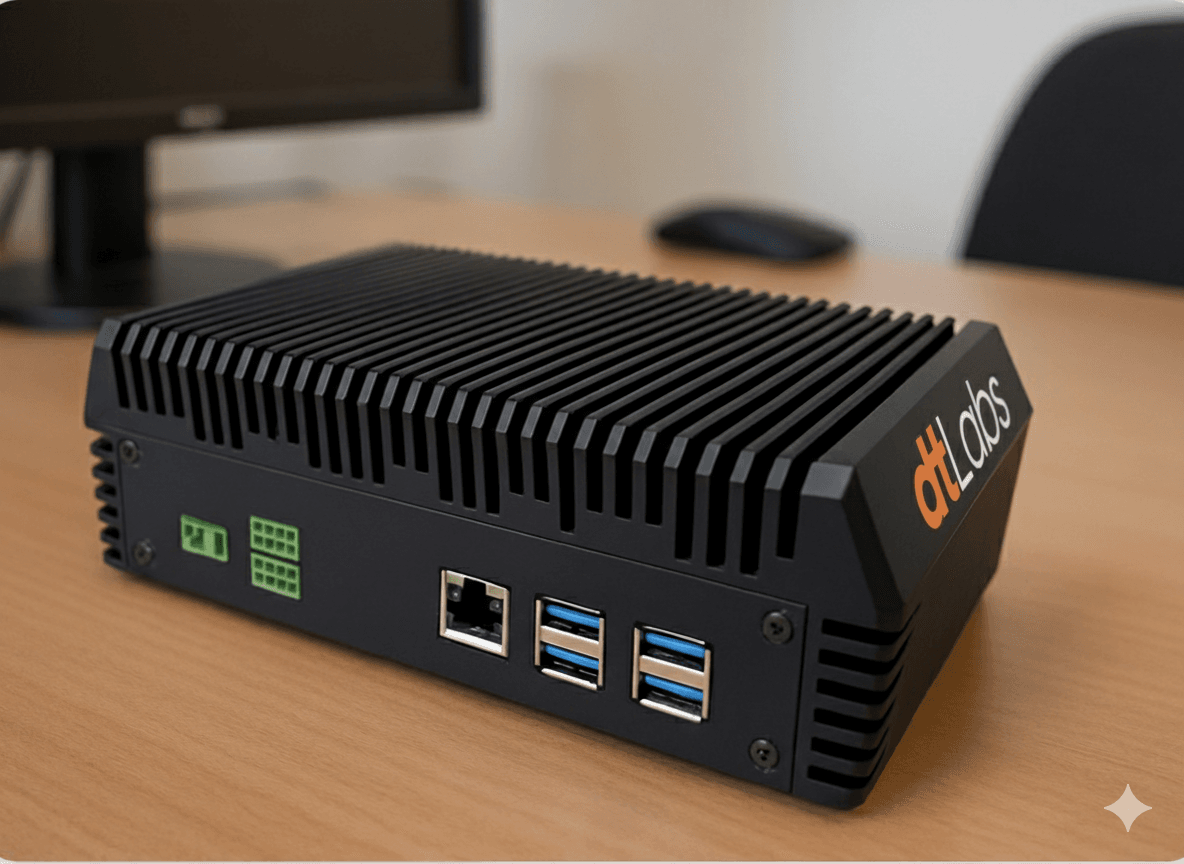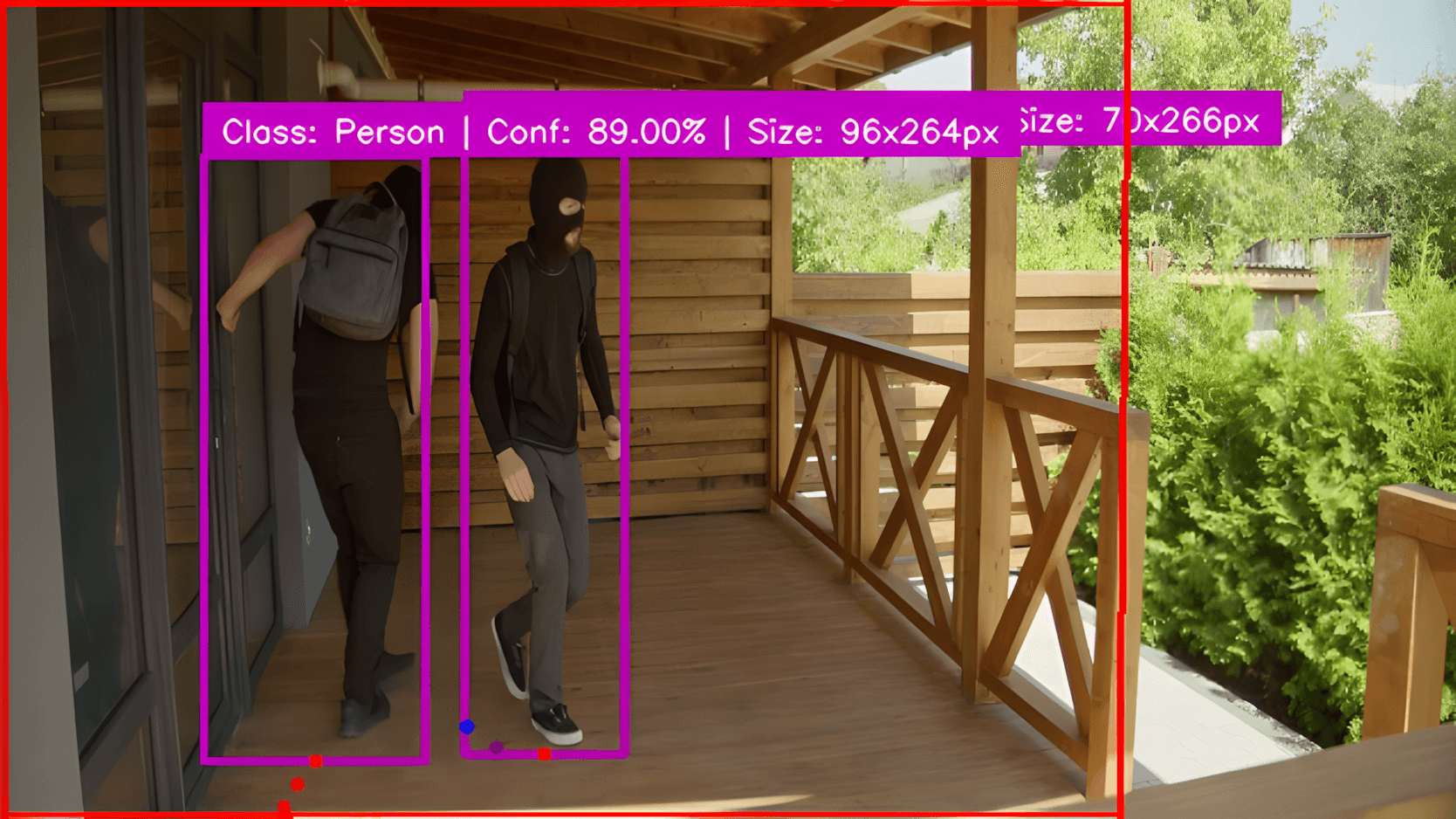Sumário
Developed by dtLabs, the AIOS platform empowers companies of any size to harness the potential of artificial intelligence and computer vision in their operations. It automates tasks such as object recognition and classification, remote monitoring, and the activation of intelligent triggers and alerts.
These capabilities can be applied to a variety of business segments, including retail, industry, agribusiness, logistics, and many others.
The AIOS platform is composed of a strategic combination of software and hardware. On the hardware side, we have the AIBox, a device specifically developed to execute artificial intelligence algorithms locally and with high performance, integrated with standard IP cameras, used to acquire images of the environments and scenarios to be monitored.
On the software side, we have AIOS itself, with its powerful pre-configured AI models and no-code interface, which allows the rapid implementation of computer vision solutions, even by users with no prior experience in the area.
In this article, we will delve deeper into the characteristics of the AIBox, its features, and the strategic role it plays in our platform. However, first we must clarify the distinctions between the concepts of Edge AI, adopted by AIOS, and Cloud AI.
Edge AI vs. Cloud AI: Understanding the Differences Between AI Architectures
In the context of artificial intelligence applications, particularly in computer vision, there are two predominant processing architectures: Cloud AI and Edge AI.
In the Cloud AI approach, all processing is performed on remote servers in the cloud (hence the name). Cameras and sensors transmit the video or raw data to those servers, which execute the algorithms and subsequently return the results.
In contrast, in the Edge AI approach used by the AIOS platform, the AI processing occurs locally, in devices like our AIBox, which run AI models directly at the edge of the network, that is, close to the data source.
While a cloud-only approach can offer advantages for massive analytics and centralized storage scenarios, it also poses critical challenges.
These include the reliance on constant and robust connectivity, with high bandwidth costs, as video streams must be transmitted in their entirety for processing. Added to this is increased latency, resulting from the time required to send, process, and return data.
Consequently, in many situations, response time can be compromised. This negatively impacts operations that require immediacy, such as security, logistics tracking, or automated decision-making in production environments.

With Edge AI, these bottlenecks are significantly mitigated. Computer vision algorithms run directly on the AIBox, which performs image processing in real time.
The result of processing is compact metadata, such as lists of recognized license plates, faces detected, or people counts. Only this metadata is transmitted to the cloud. In practical terms, instead of multiple video streams consuming tens of megabits of bandwidth per second, only a few kilobytes are sent to the platform for each detected event.
This strategy optimizes network usage, significantly reduces transmission costs, and ensures instant responses, even in environments with restricted or unstable connectivity.
In addition to better performance, the Edge AI approach strengthens data security and privacy. This is because sensitive images or videos don’t need to be transmitted outside the local environment.
In practice, this enables industries, logistics operators, and security companies to extract value from their cameras and sensors with reduced risk of exposure. At the same time, they preserve scalability and centralization of strategic analysis in the cloud.
This synergy between intelligent processing at the edge and consolidated analytics on the cloud platform ensures the ideal balance: operational agility combined with robust insights for decision-making.
AIBox: Integrating Artificial Intelligence into Your Local Network
Our AIBox integrates the power of artificial intelligence into your local network, providing greater agility and operational privacy.
Measuring 7.6 × 4.5 × 3.2 inches, it can be installed in any location that has a power outlet and a network cable (Ethernet) for internet connectivity.
Its processor is the Qualcomm® Dragonwing™ QCS6490, designed specifically for IoT (Internet of Things) applications. This chip is equipped with an 8-core Qualcomm® Kryo™ 670 CPU and a Qualcomm® Hexagon™ 770 NPU (Neural Processing Unit), capable of performing up to 12 trillion operations per second (TOPS).
This level of processing power is sufficient to analyze images from up to 16 IP cameras simultaneously, depending on the complexity of the AI models employed and the desired parameters.
The power of the AIBox can be applied to a wide range of solutions, ranging from basic event counters (for example, quantifying the flow of people in a given location per hour) to rigorous monitoring of PPE (Personal Protective Equipment) usage by employees in production environments.
This gives the AIOS platform a significant advantage compared to IP cameras that have embedded artificial intelligence.
In addition to being expensive, often in the thousands of dollars per unit, these cameras tend to be more limited in terms of supported AI models. Additionally, their integration is often limited to devices from the same manufacturer.
Besides its role in capturing and analyzing images generated by IP cameras, the AIBox can also play the role of an intelligent Programmable Logic Controller (PLC).
This is made possible by the GPIO ports (General Purpose Input/Output) integrated into the equipment. They act as relays and can be used to activate or deactivate equipment connected to them in response to detected events.
Similarly, our platform enables interaction with remote PLCs via the Modbus protocol, adding intelligence to existing equipment in your operation.

Take Your Company’s Productivity to the Next Level
dtLabs’ AIOS platform is the ideal solution for companies looking to optimize the monitoring, control and productivity of their operations through artificial intelligence.
Discover how Edge AI can transform your business. Contact us today to schedule a demo and explore the full potential of our solution.


